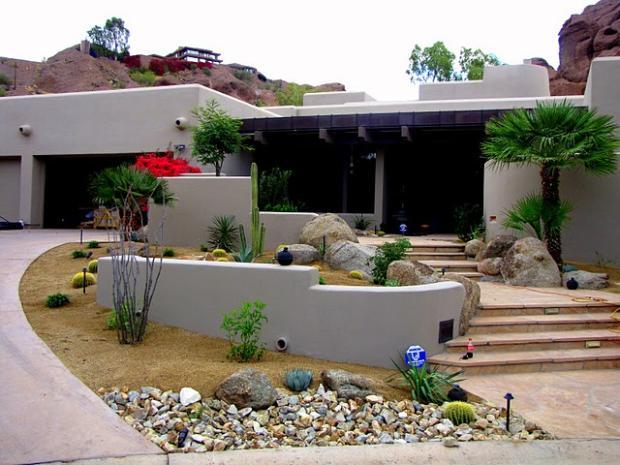Desert Landscaping: Grow Relief from the Heat
See if We Have Top-Rated
Landscpaing Contractors in Your Area

The majority of the world is undergoing some form of drought or water shortage, including the United States. Since you can't see it, you may not be too concerned with this dilemma. However, the need to conserve is ever-present in today's world, and one of the biggest wastes is lawn care. If you live in a fertile environment, such as the Midwest, you probably needn't concern yourself, but in hot, dry climates (such as the Southwest) it's almost impossible to sustain a green lawn. This is why in the last decade desert landscaping has become such a popular trend.
If you create a lawn using native wildlife, you no longer have to worry about wasteful habits and high water bills. The whole point of a yard is to showcase its natural setting. There is nothing natural about a flowerbed growing in sand. When people think of nice yards, they have a false notion of thick grass and picket fences. But this "ideal" only works if you have the natural environment to sustain it, otherwise you have a high-cost, high-maintenance mess on your hands.
Appropriate Plant Life
If your part of the country has poor soil and hot weather, then what's wrong with buying plants suitable to this atmosphere? There are lots of plants out there that are drought-tolerant and actually prefer sandy soil. Of course there are the common plants, such as cactus and yucca, which thrive in this environment, but there are also beautiful flowers out there that favor full sun. It's best to buy native perennials, such as oleander, bougainvillea, and juniper. But if you consult a professional, they can recommend various flowers (such as certain lilies and poppies) that can bloom and flourish in this setting. Another great way to conserve water is to install small window planters in or outside the home. Also, if you put climate-sensitive plants indoors near a window, you'll be able to control their environment as well as show them off to the neighbors.
Redefine "Lawn"
When people think of desert landscaping, they often think of concrete walkways, rock lawns, sagebrush, and decaying driftwood. This is certainly a common look due to its unique beauty and low-maintenance, but it's not the only to arrange a yard. In fact since concrete reflects heat instead of absorbing it, you could actually raise the temperature around your house if you have too much. Instead, try to "rethink" your lawn in terms of architecture. Add a pool or spa, install wading ponds, or create water gardens to get around the grass issue. However, this is not to say you can't have grass. Just make sure you buy native species, such as Bermuda, that can withstand the temperatures and survive the arid air.
Do your part to conserve water by using this link to install
Desert Landscaping
Water and Wind
In the Southwest the wind is just as harsh as the sun, so when planting you'll always need to give roots time to anchor. Therefore, install fences and hedges around your property or use temporary tarps and cover-ups to block the blustery weather. Also, you'll need to consult a professional landscaper to inform you of the watering timetable for your particular plant life. These experts may even be able to install a timed sprinkler system or drip irrigation system to help you conserve water. Plus, they can help with other desert landscaping options, such as pools, spas, or lighting affects.
But just in case, here is a very basic water timeline you can follow:

